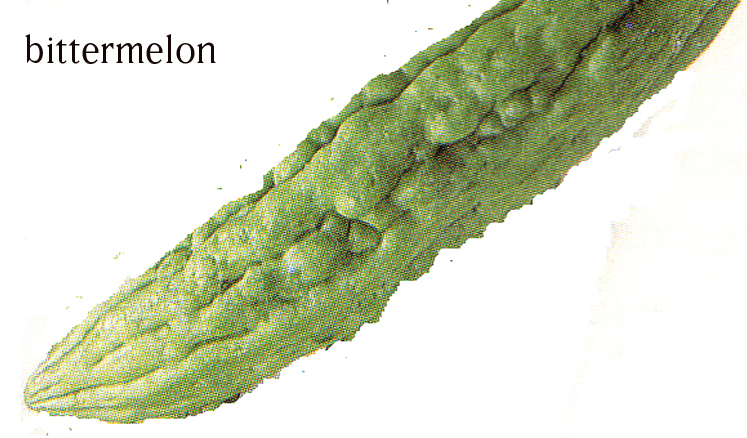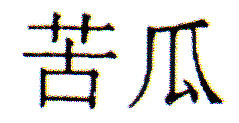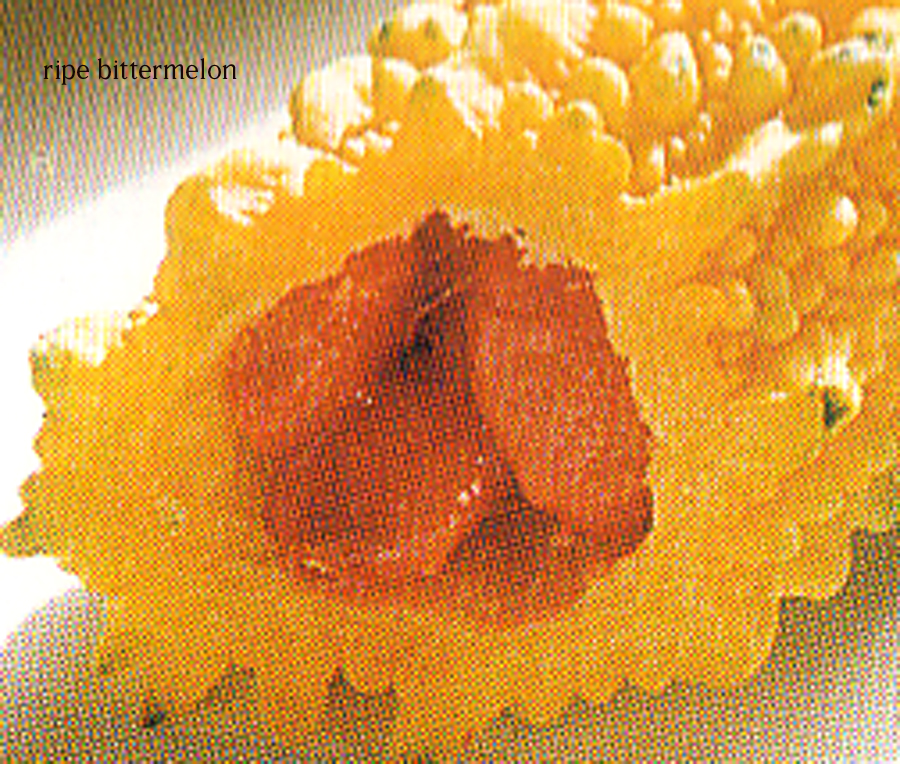
| What is Flavor and Fortune? |
| How do I subscribe? |
| How do I get past issues? |
| How do I advertise? |
| How do I contact the editor? |
Read 13125409 times
Connect me to:
| Home |
| Articles |
| Book reviews |
| Letters to the Editor |
| Newmans News and Notes |
| Recipes |
| Restaurant reviews |
| Article Index (all years, slow) |
| List of Article Years |
| Article Index (2026) |
| Article Index (last 2 years) |
| Things others say |
| Related Links |
| Log In... |
| Authors |
| Categories & Topics |
Bitter Melon
| by Jacqueline M. Newman |
Vegetables and Vegetarian Foods
Summer Volume: 2008 Issue: 15(2) page(s): 16 and 17

 The fruit of a tropical vine, bitter melon is botanically known as Morordica charantia. This and all Cucurbits or cucumber-related foods are technically fruits, and most of them have many names. Most also have yellow male and female flowers on the same plant.
The fruit of a tropical vine, bitter melon is botanically known as Morordica charantia. This and all Cucurbits or cucumber-related foods are technically fruits, and most of them have many names. Most also have yellow male and female flowers on the same plant.
Some bitter melons are not too bitter, others very bitter, and a few newer ones are actually somewhat sweet. With levels of bitterness, this family of foods are known by many names including the bitter gourd, bitter cucumber, balsam pear, and kerala. Several of its relatives such as the pumpkin and luo han, for example, are exceptionally sweet. The ones in this article, and the balsam apple which is Morordica balsamina are quite bitter.
Some say these fruits originated in either Africa or India, or both, Long known and indigenous to tropical regions of Asia and Southeast Asia, both the balsam pear and the balsam apple are popular and used often in China, Africa, India, and Indonesia. The Portuguese brought them to Brazil in the 16th or 17th century, and they are now grown in North and South America countries, the United States included. Wherever, the Chinese call them ku gua, though there are some who call them lai gua. In India they refer to them as kerala, and in other countries they have other names for them.
One variety, the balsam apple, probably did originate in Malaysia, but it is now common to all tropical parts of the world. Most folk use it in curries. Some bitter melon cultivars are native to tropical Asia with several of these found in the Guangzhou region, where they are most popular. The varieties from this southern Chinese region are: Broad Shoulder. Smooth Body, Slippery Body, and Long Body. Though there are all these kinds, most just purchase the bitter melon not knowing which variety it is.
 This family of foods likes a warm climate where they can grow as long as the common cucumber looking like one with a bumpy, shiny, warty exterior. All varieties are not only used in many cuisines but in many of their healing practices. This ku gwa or bitter melon has a dark green color when mature. Some say it evolved to deter consumption by animals. That may be a myth, the actual reason be an unknown. What is known is that it turns yellow-orange, sometimes slightly red when very ripe as seen in the illustration, and that the seeds almost always turn red when very ripe.
This family of foods likes a warm climate where they can grow as long as the common cucumber looking like one with a bumpy, shiny, warty exterior. All varieties are not only used in many cuisines but in many of their healing practices. This ku gwa or bitter melon has a dark green color when mature. Some say it evolved to deter consumption by animals. That may be a myth, the actual reason be an unknown. What is known is that it turns yellow-orange, sometimes slightly red when very ripe as seen in the illustration, and that the seeds almost always turn red when very ripe.
China grows many varieties of the bitter melon as does Taiwan. The bumpy one is the common one but there are some with a smoother exterior. Most of these taste less bitter than other cultivars. Moonshine is a newer variety, it is bumpy and white but is rather bitter. Its seeds and those of others lose their viability rapidly so germination can be a problem. One way to combat this is to soak the seeds of all bitter melons before planting them.
In the south of China and throughout Taiwan, people cook this fruit as a vegetable. They remove the seeds and the fibrous pulpy material around them and soak the cut pieces in water to reduce some bitterness. And in these countries, this food item is best loved when prepared with beef and fermented black beans. Southern Chinese cooks prepare it with other meats, fish, and bean curd, or all of them together in one dish.
Not everyone soaks this fruit to remove some bitterness. They simply use it after cutting it into pieces as they like the bitter taste. The leaves and the vines are also used as vegetables; both are less bitter, but bitter, nonetheless. They are thinner than the vines of cucumber or related plants, and cutting and cooking them is common among those who grow them. Others may not know this as they and we have never seen these parts of the plant in the marketplace.
The Chinese know that edible parts of this plant are nutritious; and they believe that medicines should taste bitter. So mixing bitter melon into medicines is very common. That is why they like this plant for health purposes, and why the bitterness does not bother them. All bitter melon-related fruits, sweet or bitter, are used in soups, to make teas, and in a variety of stewed or stir-fried dishes. Not every one calls this food 'bitter melon.' Some call it Red Maiden, and some call it Elegant Lychee. The former may be because of its red seeds, the reason for the latter we know not.
Few speak of the bitter melon as a gourd, but actually it is one. It has been cultivated in the Guangzhou region for hundreds if not thousands of years and early medicinal reports say that while bitter, it does have a sweet aftertaste. Traditional medicine doctors (TCM) recommend it for its laxative properties and as a cooling liang tea called liang cha.
The Chinese believe bitter melon is cool in nature and that it affects heart, liver, and lungs. TCM practitioners say it relieves heat stroke, brightens the eyes, and neutralizes poisons. They recommend it for relief from the common cold in hot weather, for body aches and pains all year long, and for neutralizing any bitter taste in the mouth. They also make a paste of the fruit and recommend it be applied as a dressing on the stomach when it aches, and they use it for pain relief on boils and carbuncles. They also take some internally, mixing it in equal parts with wine, for the above conditions.
Many questions come to the magazine about this fruit. We recommend contacting the National Bitter Melon Council in Jamaica Plain, Massachusetts at www.bittermelon.org or at info@bittermelon.org. Their website has general information including that this fruit is rich in iron, has twice the potassium of bananas, and is widely used to treat intestinal disorders, etc. They did publish a bitter melon cookbook a few years ago, some copies may still be available; and we do wish we had one. They correctly advise that the Food and Drug Administration in the United States Department of Agriculture has not yet sanctioned this plant for any medicinal use. Be advised that they, like ISACC, are a small organization and that both staffs work pro bono. So, if you do query them, a response may not come as promptly as you might like. This magazine did an article about this food in Volume 10 (3) on pages 25 and 26. If you want a copy, it is available from the Flavor and Fortune web site.
Below are some common southern Chinese recipes worth trying. Use the common Chinese varieties and not the common Indian one, kerala. That variety stays bitter with or without soaking, and our Chinese friends say it is even too bitter for them.
| Fish with Bitter Melon |
|---|
1 Tablespoon vegetable oil 3 cloves of garlic, peeled and smashed with the flat blade side of a cleaver 1 small onion, cut top to root in half-inch sections 1 pound firm bean curd, cut into two-inch cubes 2 bitter melons, seeds and pulp discarded, sliced into half-inch circles 1/2 pound of any skinless and boneless white fish fillet 1 Tablespoon minced peeled fresh ginger 1/2 teaspoon coarse salt 1 cup chicken or fish broth or water 2 teaspoons sesame oil Preparation: 1. Heat wok or fry pan and add the oil, then the garlic and onion pieces and stir-fry for one minute, before adding the bean curd. Let that fry until golden brown, then turn bean curd over to fry on its other side. 2. Sprinkle bitter melon pieces on the bean curd and top with the fish fillet; then scatter ginger and salt over this, and pour the broth down the side of the wok or pan, and cover it and simmer for three minutes before removing the cover and adding the sesame oil. 3. Transfer to a pre-heated bowl, and serve. |
| Bitter Melon with Beef |
|---|
2 Tablespoons vegetable oil 2 cloves garlic, peeled and minced 2 bitter melons, cut in half with seeds and pith discarded, then sliced into quarter-inch half moons on an angle, soaked in cold water for half an hour, then drained 2 teaspoons fermented black beans, rinsed and crushed with the side of a cleaver 1 teaspoon minced fresh ginger 1/2 pound beef filet, cut into thin slices or strips 1 Tablespoon Chinese rice wine 1 Tablespoon thin soy sauce 1 teaspoon sugar 1/2 teaspoon coarse salt 1 Tablespoon cornstarch mixed with two teaspoon cold water Preparation: 1. Heat oil in wok or fry-pan and fry garlic for half minute, then add black beans and bitter melon, and stir-fry for two minutes before adding the ginger and stir-frying for another minute. 2. Add the beef, and stir-fry for one minute until no longer pink, then add the rice wine, soy sauce, sugar and salt, and stir before adding the cornstarch mixture. Stir-fry about half minute until sauce thickens, then serve. |
| Stuffed Bitter Melon I |
|---|
2 Tablespoons vegetable oil 2 cloves garlic, peeled and minced 2 Tablespoons fermented black beans, mashed with side of the cleaver 3 shrimp, shells and veins removed, and minced 1/4 pound ground pork 2 scallions, minced 2 teaspoons thin soy sauce 1 teaspoon cornstarch 1 teaspoon sugar 1 large bitter melon, cut in half, seeds and pulp removed and discarded 1/4 teaspoon ground white pepper 2 Tablespoons Chinese rice wine 1/2 teaspoon salt Preparation: 1. Heat oil and stir-fry the garlic and the fermented beans for one minute, then remove from the wok or fry-pan and stir in the shrimp and the pork, mixing well. Then add the scallions. Soy sauce, cornstarch, and sugar. 2. Stuff the meat-shrimp mixture into the two bitter melon halves and add the rice wine, pepper and salt and one-quarter cup water. Add it to the wok or fry-pan, meat-side down, cover, and simmer for fifteen minutes. Remove the cover, and reduce the remaining liquid by half. 3. Put the bitter melon pieces on a cutting board, cut them into half-inch pieces. Place then cut-side up on a pre-heated platter, pour any liquid remaining over them, and serve. |

Copyright © 1994-2026 by ISACC, all rights reserved
Address
3 Jefferson Ferry Drive
S. Setauket NY 11720